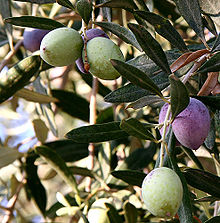| Olive Temporal range: Late Pleistocene to recent,
| |
|---|---|

| |
| Scientific classification | |
| Kingdom: | Plantae |
| Clade: | Tracheophytes |
| Clade: | Angiosperms |
| Clade: | Eudicots |
| Clade: | Asterids |
| Order: | Lamiales |
| Family: | Oleaceae |
| Genus: | Olea |
| Species: | O. europaea
|
| Binomial name | |
| Olea europaea | |

| |
| Distribution map of Olea europaea s.l. | |
The olive, botanical name Olea europaea, meaning 'European olive', is a species of small tree or shrub in the family Oleaceae, found traditionally in the Mediterranean Basin, with wild subspecies found further afield in Africa and western Asia. When in shrub form, it is known as Olea europaea 'Montra', dwarf olive, or little olive. The species is cultivated in all the countries of the Mediterranean, as well as in Australia, New Zealand, North and South America and South Africa.[2][3] It is the type species for its genus, Olea. The tree and its fruit give their name to the Oleaceae plant family, which also includes species such as lilac, jasmine, forsythia, and the true ash tree.
The olive's fruit, also called an "olive", is of major agricultural importance in the Mediterranean region as the source of olive oil; it is one of the core ingredients in Middle Eastern and Mediterranean cuisines. Thousands of cultivars of the olive tree are known. Olive cultivars may be used primarily for oil, eating, or both. Olives cultivated for consumption are generally referred to as "table olives".[4] About 80% of all harvested olives are turned into oil, while about 20% are used as table olives.
- ^ Magos Brehm, J.; Draper Munt, D.; Kell, S.P. (2011). "Olea europaea (errata version published in 2016)". The IUCN Red List of Threatened Species 2011. e.T63005A102150835. Archived from the original on 30 June 2021. Retrieved 26 June 2021.
- ^ "Kew World Checklist of Selected Plant Families, Olea europaea". Royal Botanic Gardens, Kew. Archived from the original on 20 January 2012. Retrieved 5 December 2014.
- ^ "Olea europaea (map)". Biota of North America Program. Archived from the original on 9 May 2015. Retrieved 5 December 2014.
- ^ Cite error: The named reference
Fernández, A. Garrido 1997was invoked but never defined (see the help page).
